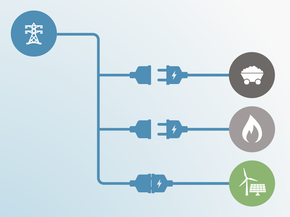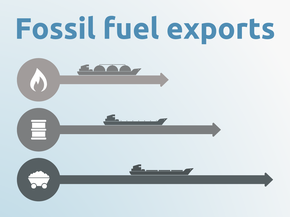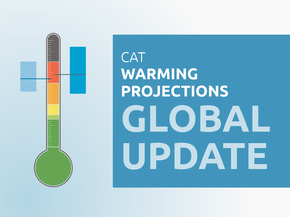Current Policy Projections
Current policies overview
Australia’s current policies fall far short of the emissions reductions required to meet the 2030 target put forward in its NDC. Under current policies in place, Australia’s total GHG emissions excl. LULUCF are projected to rise to 555 MtCO2e by 2020 and 570 MtCO2e by 2030. This is equivalent to an increase in emissions from 2005 levels (excl. LULUCF) of 6% and 9% by 2020 and 2030, respectively (when compared to 1990 levels (excl. LULUCF) this results in an increase of 32% and 36% respectively). To meet its “Insufficient” 2030 emissions targets, Australian emissions should decrease by an annual rate of 1.5% to 1.7% until 2030; instead, with current policies, they are set to increase by an annual rate of around 0.3% per year.
Australia’s Emissions Reduction Fund (ERF) is a reverse auction mechanism that aims to “reduce emissions at lowest cost over the period to 2020” (Australian Government, 2014, p. 68). However, this so-called “centrepiece” of the Australian government’s policy suite to reduce emissions does not set Australia on a path towards meeting its NDC target.
In October 2018 the Clean Energy Regulator, which serves as economic regulator of the fund, cancelled projects worth a total of AUD 24 million because they did not deliver the necessary cuts to carbon emissions (Cox, 2018). The funds will be redirected to new projects. The eighth auction of the fund will be held on 10–11 December 2018 (Clean Energy Regulator, 2018). With only over AUD 250 million remaining of the initial AUD 2.55 billion the future of the fund remains in question.
The ERF is also the subject of fiscal concern due to its cost to the taxpayer. The government-appointed advisory body Climate Change Authority has reiterated its advice to not rely on the ERF and introduce new policies aiming at decarbonisation and structural change (CCA, 2017). In addition to fiscal concerns, the fund is plagued by a multitude of other issues: the fund’s administrative complexity, as well as the low average auction price, pose barriers to participation, in particular for high emitting companies (Reputex, 2017). Business interest in the scheme has seen a steady decline, with less than 7 million contracted abatement units cleared in the most recent round of auctions (The Guardian, 2018a). The fund is also plagued by a mismatch of its abatement profile (concentrated in the land sector) with Australia’s emissions profile, which is driven by industrial and power sectors. There is a high risk of reversal of stored carbon in land sector projects being emitted again (Vorrath, 2017, CCA 2017). There are also serious doubts about the additionality of many of the ERF projects (Baxter, 2017).
Alongside the reverse auction, the ERF includes a safeguard mechanism, which began operations in July 2016, with a goal of limiting significant emissions increases from large industrial sources to a baseline emissions level. This mechanism applies to around 140 businesses that have facilities with direct emissions of more than 100 ktCO2e. High-emitting industrial facilities covered by the safeguard mechanism are projected to drive national emissions growth through to 2030, as they are permitted to increase emissions baselines, leading to a projected increase of emissions from these facilities by 16% since the commencement of the scheme (Reputex 2018), potentially cancelling out publicly funded emissions reductions under the ERF (The Guardian, 2018b). The government consulted with industry stakeholders on how to make the safeguard mechanism “fairer and simpler”, without addressing these issues, and with the proposed changes risking an increase in the level of emissions allowances (Australian Government, 2018a).
Energy
Australia’s primary energy consumption is dominated by fossil fuels; in 2015-16 37% came from oil, followed by 32% coal, 25% gas, followed by a mere 6% of renewable energy (Australian Government, 2017c). In 2016, federal and state energy ministers commissioned a review of the national electricity market, the so-called “Finkel Review”. The review highlights “the need for a clear and early decision to implement an orderly Transition” and recommends that the Australian State and Territory governments agree to an emissions reduction trajectory for the National Electricity Market and the adoption of a Clean Energy Target (Finkel, 2017).
The minimum electricity sector emissions reduction pathway suggested in the Finkel Report (26–28% reduction from 2030 levels from 2005), however, is not consistent with other scientific assessments, as its reductions only track the (already insufficient) 2030 reductions proposed for the entire Australian economy (Hare et al., 2017). The federal government has now even rejected the inadequate National Energy Guarantee (NEG), and refuses to discuss any emissions reduction policy for the electricity sector. The government claims it wants to focus on reducing prices and supporting investment in coal and gas to ensure reliability.
Driven by the notion of low-electricity prices, the federal government aims to introduce several policies ostensibly aimed at maintaining the competitiveness of coal-based generation (Murphy, 2018). These include an underwriting programme with the provision of floor prices, contracts for difference, and loan provisions. Such policies work at cross purposes with the stated objective, given the rapid decline in costs of renewables (RenewEconomy, 2018c).
This stands in stark contrast to the need reduce the use of coal in electricity by two-thirds between 2020–2030 globally and phase out coal by 2050, as found by the IPCC Special Report on Global Warming of 1.5 °C (IPCC, 2018). The Australian government is refuting the key messages of the IPCC report stating that the report did not “provide recommendations to Australia” (Hannam & Latimer, 2018). OECD countries, including Australia, need to phase out coal by 2030 (Climate Analytics, 2016; Powering past coal Alliance, 2017).
Australia’s Renewable Energy Target, introduced in 2010, aims at increasing the share of electricity generation from renewable sources. It consists of two targets: the Small-scale Renewable Energy Scheme, which supports small-scale installations like household solar panels and solar hot water systems, and the Large-scale Renewable Energy Target (LRET). The LRET originally aimed to achieve 41 TWh of additional renewable electricity generation by 2020, but, in 2015, the government reduced this target to 33 TWh. In the same year, coal consumption rose by 3%, due to increased black and brown coal use in electricity generation (Australian Government, 2016).
Australia is home to the world’s largest battery storage plant (100 MW/129 MWh) and installed an estimated 20,800 battery storage systems in 2017, tripling the number of systems added in 2016 (Latimer, 2018). Most of these were sold in combination with rooftop solar photo voltaic panels, driven by rising retail rates and the desire to maximise solar power self-consumption (Roberts, 2017). Distributed solar-plus-storage has become cheaper than retail electricity from the grid in several regions of Australia.
Despite this, coal has featured prominently in government statements on energy security and the future of Australia’s power system. However, on the ground, there is little appetite for new coal generation from utilities and industry, nor from the general public. Nine coal power stations have been retired in the last five years, including Hazelwood, a 1,600 MW lignite coal-fired plant. This illustrates the economic challenges coal plants face in Australia against continuously decreasing costs of renewables and storage. There is increasing concern about the lack of reliability of aging coal fire power plants, with renewable energy and increasing use of modern storage technologies proving to contribute more and more to reliability (IEEFA, 2018), (Gas Coal Watch, 2018; RenewEconomy, 2018b).
Due to the politically unstable environment on climate policy, investment uncertainty remains high over what kind of power plants to build as ageing coal plants are shut down or are increasingly unreliable. Wholesale power prices have doubled since the carbon price scheme and related legislation was axed, fuelling calls for an emissions intensity-based carbon pricing scheme for the electricity sector (The Sydney Morning Herald, 2017). Even this measure was ruled out by the Turnbull government, although analysis suggests it could save households and businesses up to AUD 15 billion in electricity bills over a decade (The Sydney Morning Herald, 2016).
Unabated gas, like coal, has a limited best before date before it needs to be phased out for a Paris compatible future (Climate Action Tracker, 2018). However, liquefied natural gas (LNG) has been the biggest driver of Australia’s carbon footprint in the last three years (The Guardian, 2018d). Large projects, such as the Browse LNG plant have been submitted for environment approval without plans to reduce or offset greenhouse gas emissions, with emissions from LNG projected to neutralise emissions avoided through the national renewable energy target (The Guardian, 2018f).
Within the energy sector, direct combustion emissions are increasing and projected to increase further with the ramping up of LNG export facilities, mainly in Western Australia and Queensland. Australia is projected to become the world largest LNG exporter by 2020. This increase in gas production is also leading to an increase in fugitive emissions, with questions regarding the emissions reporting leading to concerns that emissions might be higher than presently reported (Hare, Roming, Hutfilter, Schaeffer, & Beer, 2018).
On the subnational level, climate action is more visible. South Australia is close to achieving its 50% renewable energy target that was set for 2025, and is on track to meet the aspirational target of 75% share of renewable energy in power generation by 2025 that the previous government had announced (AEMO, 2017b).
South Australia also aims to achieve net zero greenhouse gas emissions by 2050 (Government of South Australia, 2016). South Australia is a global leader in terms of share of variable renewable energy (wind and solar PV now at a share of 48% (AEMO, 2017a), second globally behind Denmark) as well as storage technology with the world’s biggest lithium-ion battery and one of the world’s biggest solar thermal plants. The state also has plans for the world’s biggest “virtual power plant”, i.e. the installation of solar panels and batteries on more than 50,000 homes, and for investments into green hydrogen from renewable energy for storage and export (The Guardian, 2018e).
Australia was the world’s seventh top installer of solar photo voltaic (PV) capacity in 2017, and ranks fifth globally for total capacity per inhabitant. This is almost exclusively due to the incredibly high rates of solar PV installations found on rooftops of Australian homes. About 29% of dwellings in South Australia and 27% in Queensland had solar PV by early 2018, with substantial shares in several other states and territories as well, a trend that is showing no sign of slowing down.
A record 351MW was installed in the first quarter of 2018 and it looks like this will continue for years (RenewEconomy, 2018a). This is not a boom driven by a pending reduction in subsidies, but by high electricity prices, highly affordable solar power system and people’s desire to do act on climate change.
A recent study finds that Australia could build an affordable and secure electricity network with 100 percent renewable energy, using existing technologies (Blakers, Lu, & Stocks, 2017). A report by the Commonwealth Scientific and Industrial Research Organisation (CSIRO) and Energy Networks Australia (ENA) finds that a decarbonised energy grid by 2050, with half of generation produced and stored locally, will save billions in upfront capital costs and consumer bills, and deliver a secure electricity system (Australia Energy Networks & CSIRO, 2016).
The National Energy Productivity Plan 2015–2030 aims to improve energy productivity by 40% by 2030 through “encouraging more productive consumer choices and promoting more productive energy services” (Australian Government, 2015). However, research suggests that much more ambitious improvements are possible, with a doubling of energy productivity possible by 2030 with net benefits for GDP (Energetics, 2015). Almost four years after its publication its impact is yet to materialise. Along with setting and encouraging efficiency standards, governments can support energy efficiency improvements across sectors by setting ambitious goals, providing funding and financial incentives. The American Council for an Energy-Efficient Economy (ACEEE) has scored these elements of national commitment and leadership—Australia is situated in the last rows with rank 18 of 25 (Castro-Alvarez, Vaidyanathan, Bastian, & King, 2018). The IEA comes to the same conclusion: As one of a total of 28 countries it is the only country making no real progress (OECD/International Energy Agency, 2017).
Transport
Emissions in the transport sector are increasing and are projected to increase further. Despite this development, there are barely any policies in place. The government is relying on financing for businesses to upgrade their fleets, with just over 1000 lower-emissions vehicles financed through industry partnerships (Government Climate Policy Review 2017, p33) The government provides exemptions from some vehicle taxes for highly efficient vehicles. Only six ERF projects have been registered to improve vehicle efficiency (ref. see above), mostly focusing on heavy transport and ships.
The government established a Ministerial Forum to coordinate federal and state government approaches to addressing emissions from motor vehicles, including consideration of a fuel efficiency standard for light vehicles (Government Policy review, 2017). While nearly 80% of new light duty vehicles sold globally are subject to some kind of emissions or fuel economy standard, Australia does not have any efficiency or emissions standards for passenger vehicles, which cause the largest share of emissions, only relying on information programmes such as the Green Vehicle Guide and the Fuel Consumption Labelling Standard (Vieweg et al., 2017).
Adopting strict standards could prevent up to the equivalent of 65 MtCO2 by 2030, which is significantly more greenhouse gas pollution than what New South Wales’ entire coal fleet produces in a year (Climate Council, 2018). They would also significantly reduce car owners’ fuel bills, saving an estimated AUD 8,500 over a vehicle’s lifetime.
Compared to other countries, the uptake of electric vehicles (EVs) is very slow in Australia. The current uptake rate is around 0.1% of new vehicle sales. This is projected to increase to only 0.3% by 2020 and 15% by 2030 (Australian Government, 2017a, p. 37). Despite this slow progress, no policies are in place to incentivise use or support charging infrastructure.
The only exception is the State of South Australia, which has recently introduced a tax incentive for EV purchase. The ACT government and Transport Canberra have trialled electric and hybrid buses and ACT has now released an Action Plan for zero emissions vehicles. ACT—with a target to achieve net zero GHG emissions by 2045—has introduced financial incentives for zero emissions vehicles (exemptions from stamp duties, reduced registration fees), adopted zero emissions vehicles in government fleet, and is investigating opportunities for production of hydrogen fuel and deployment of fuel cell Electric Vehicles in the government fleet (ACT Government, 2018).
Industry
Based on the most recent quarterly inventory Australia’s emissions from fossil fuels and industry continue to rise and, are now 6% above 2005 levels and increasing at around 2% since 2014(Australian Government, 2018b). Many studies have shown that Australia can decarbonise its industry sector and transition away from fossil fuels by 2050. The IEA has pointed out the vast opportunities in Australia based on the “extreme abundance of solar and wind resources” to spur international trade in renewables-based, hydrogen-rich chemicals and fuels (IEA, 2017). In this sector, too, subnational action is on the rise while the federal government’s action lags behind.
South Australia is betting on a hydrogen economy on the horizon, having recognised the tremendous benefits and opportunities attached to it (New South Australia, 2018). Experts say that with the right conditions, Australian hydrogen exports could be worth AUD 1.7 billion a year and could generate 2,800 jobs by 2030 (ACIL Allen Consulting, 2018). It's no wonder South Australia has its eye on the prize, and it has developed a Hydrogen Road Map that sets out a clear course towards a hydrogen economy. South Australia aims to capitalise on its competitive advantages, including high renewable energy deployment, and wind and solar resources, to accelerate the transition to being a producer, consumer and exporter of hydrogen (Government of South Australia, 2017). It will host Australia’s first renewable-hydrogen electrolyser plant, a.k.a. “liquid sunshine” producer.
Other states are starting to recognise their potential, with the Premier of Western Australia (WA) recently announcing the establishment of a Renewable Hydrogen Council to develop a state strategy. This strategy should will build on WA’s vast potentials, extensive experience with natural gas infrastructure that can be applied to hydrogen, and specific opportunities including for export to existing and future markets for LNG (Perera, 2018).
Legislation was passed by Parliament on 19 June 2017 enabling the start of a phase- down of HFC imports from 1 January 2018. The phase-down will reduce the total quantity of permitted HFC imports every two years until an 85% reduction from 2011–2013 levels is achieved by 2036 (Government, 2017).
Agriculture
Agriculture emissions are projected to increase by 8% above 2020 levels in 2030, with beef cattle projected to continue to be the biggest contributor, with an increase in grain fed beef cattle and growth in exports contributing to the increase in emissions (Australian Government, 2017b).
Forestry
According to the latest projection report, net emissions from the LULUCF sector are expected to decrease slightly to become a small net sink in 2020, with a short-term rise in land clearing emissions offset by higher carbon sinks from forests and plantations. From 2021 to 2030, net emissions are projected to increase initially, before stabilising around 2025, with emissions from land clearing projected to follow a declining trend, assuming a relatively stable clearing rate and a high proportion of clearing activity of young, less biomass-intensive, regrowth forest.
However, it is not clear how these projections take into account the alarming increase in deforestation rates observed and projected in particular in Queensland, where about 395,000 hectares of native vegetation were cleared in 2015-16, 33% more than the previous year (Queensland Government, 2017). Australia the only developed country deforestation hotspot in the world, with estimates that three to six million hectares of forest could be lost by 2030 in Eastern Australia (The Guardian, 2018c; WWF, 2018).
Further analysis
Latest publications
Stay informed
Subscribe to our newsletter







